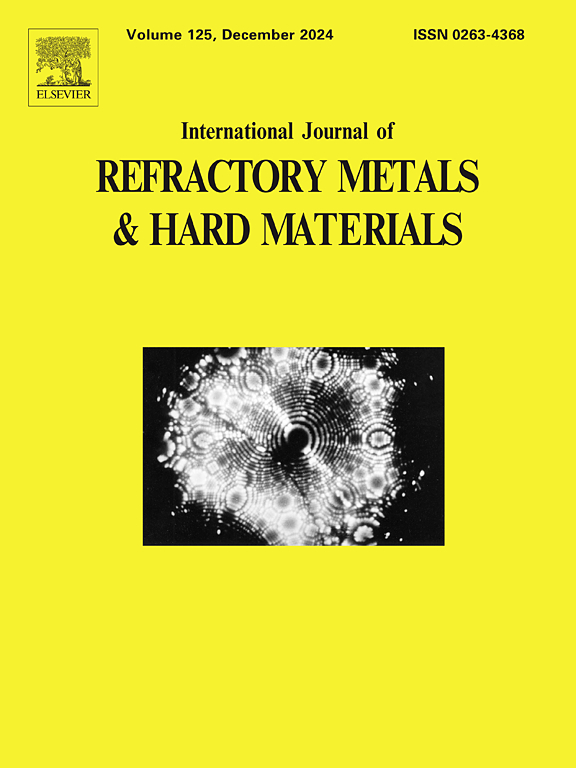Effect of chromium doping on the grain boundary character of WC-Co
IF 4.2
2区 材料科学
Q2 MATERIALS SCIENCE, MULTIDISCIPLINARY
International Journal of Refractory Metals & Hard Materials
Pub Date : 2024-11-07
DOI:10.1016/j.ijrmhm.2024.106954
引用次数: 0
Abstract
The life of cutting tool inserts is critically important for efficient machining, reducing manufacturing cost, embedded energy, and enabling more complex parts to be machined. For these applications, cemented carbide (WC-Co) materials are a prime candidate. The performance of these materials can be limited by early fracture, typically via an intergranular fracture path with respect to carbide grains. This motivates further studies to understand the character of the grain boundary network so that grain boundary engineering (GBE) of WC-Co tools can be used to improve tool life and performance. In this work, we have used Rohrer et al.'s five-parameter grain boundary character distribution (GBCD) analysis to examine the grain boundary network of WC-10wt%Co and WC-10wt%Co-1wt%Cr samples (Rohrer et al., 2004a [1]). It was found that the measured area fraction of the Σ2 boundaries was comparable to the values reported in the literature despite the relatively larger grain sizes (∼14 μm) and higher cobalt contents. The result suggests that chromium doping increases the area fraction of Σ2 boundaries from 12.8 % to 14.8 %. It is proposed that this is a consequence of altering the Σ2 boundary energy, as associated with adding chromium.
铬掺杂对 WC-Co 晶界特性的影响
切削工具刀片的使用寿命对于高效加工、降低制造成本、节约能源以及加工更复杂的零件至关重要。在这些应用中,硬质合金 (WC-Co) 材料是首选。这些材料的性能会受到早期断裂的限制,通常是通过相对于硬质合金晶粒的晶间断裂路径。这促使我们进一步研究了解晶界网络的特征,从而利用 WC-Co 工具的晶界工程 (GBE) 来提高工具的寿命和性能。在这项工作中,我们使用 Rohrer 等人的五参数晶界特征分布 (GBCD) 分析方法来研究 WC-10wt%Co 和 WC-10wt%Co-1wt%Cr 样品的晶界网络(Rohrer 等人,2004a [1])。研究发现,尽管晶粒尺寸相对较大(∼14 μm),钴含量也较高,但测得的Σ2 边界面积分数与文献报道的数值相当。结果表明,铬掺杂使 Σ2 边界的面积分数从 12.8% 增加到 14.8%。据推测,这是与添加铬有关的Σ2边界能量改变的结果。
本文章由计算机程序翻译,如有差异,请以英文原文为准。
求助全文
约1分钟内获得全文
求助全文
来源期刊
CiteScore
7.00
自引率
13.90%
发文量
236
审稿时长
35 days
期刊介绍:
The International Journal of Refractory Metals and Hard Materials (IJRMHM) publishes original research articles concerned with all aspects of refractory metals and hard materials. Refractory metals are defined as metals with melting points higher than 1800 °C. These are tungsten, molybdenum, chromium, tantalum, niobium, hafnium, and rhenium, as well as many compounds and alloys based thereupon. Hard materials that are included in the scope of this journal are defined as materials with hardness values higher than 1000 kg/mm2, primarily intended for applications as manufacturing tools or wear resistant components in mechanical systems. Thus they encompass carbides, nitrides and borides of metals, and related compounds. A special focus of this journal is put on the family of hardmetals, which is also known as cemented tungsten carbide, and cermets which are based on titanium carbide and carbonitrides with or without a metal binder. Ceramics and superhard materials including diamond and cubic boron nitride may also be accepted provided the subject material is presented as hard materials as defined above.

 求助内容:
求助内容: 应助结果提醒方式:
应助结果提醒方式:


